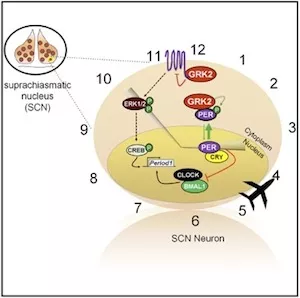
GRK2 Fine-Tunes Circadian Clock Speed and Entrainment via Transcriptional and Posttranslational Control of PERIOD Proteins
Hickory, dickory, dock, the mouse went up the circadian clock, the clock struck 12, the mouse got a GRK2 knock-out, and the clock no longer goes hickory, dickory, dock. Explosive new results published in Cell Reports from the Cheng lab are changing our understanding of the genetic mechanisms of circadian rhythms. A team of students --Neel Mehta (MSc grad), Arthur Cheng (MSc candidate), Lucia Mendoza-Viveros (PhD candidate), Harrod Ling (MSc grad) and Abhilasha Patel (former BIO481 student)—collaborated to investigate the role of the G protein-coupled receptor kinase 2 (GRK2) in the mammalian circadian clock. Using GRK2 knockout mice, they found that this gene is important for regulating the pace of the circadian clock and its ability to synchronize to the day-night cycle. After an exhaustive search for mechanistic answers, the students found that the molecular basis of GRK2's actions on the circadian clock involved transcriptional modulation of a core clock gene, Period1, and post-translational regulation of nuclear trafficking of PERIOD1/2 proteins. In a new twist, the impact of GRK2 on the clock may not be entirely dependent on its canonical function as a kinase for GPCRs, since they found that GRK2 can physically bind to PERIOD1/2 proteins and promote the phosphorylation of PERIOD2, thus pointing to a potentially novel function of GRK2.
Congrats, Cheng Lab!
